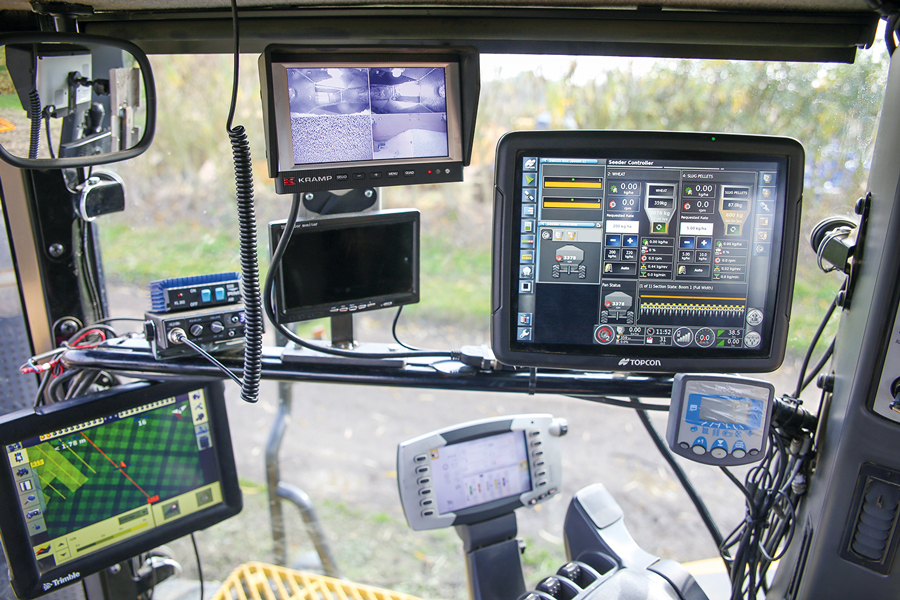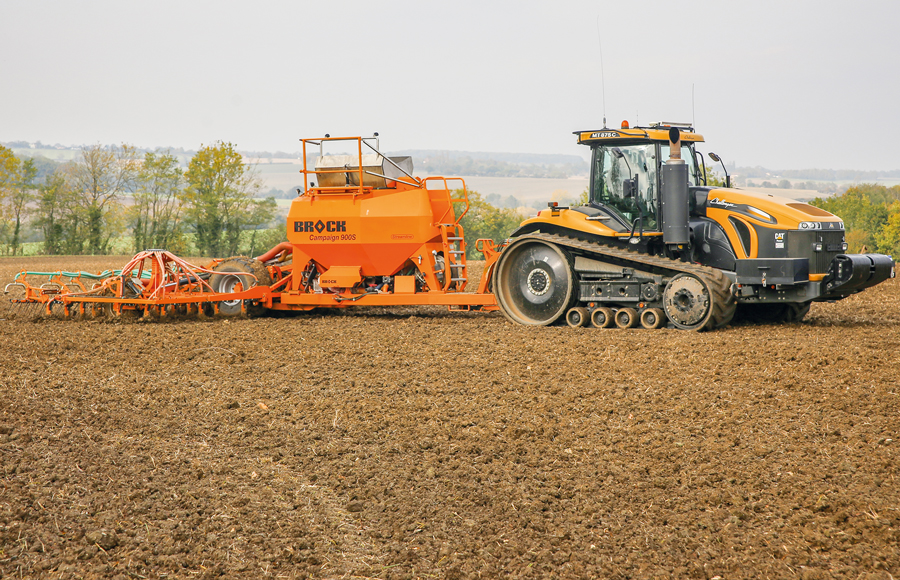New drill impresses test users ahead of limited production next year
19th December 2019
A new tine drill, designed to cope with some of the heaviest clay soils, has continued working in wet conditions in Essex when most other drills had returned to their sheds. David Williams saw it at work.
Essex-based J Brock & Sons has a reputation for manufacturing durable, practical machinery, and when a prototype version of the company’s new Campaign Drill had its first public demonstration in autumn 2016, there was plenty of interest. Development continues to refine the design, but a limited number will be available to purchase next year.
Practical design
A move to late autumn drilling of winter crops in recent years has led to increased demand for drills capable of operating in wetter weather and the Brock Campaign Drill, in working widths up to 13.5m, will suit the needs of large, professional farms and has a specification to match.
The Campaign Drill line-up includes working widths from 6–13.5m, all trailed. Heavy-duty low disturbance spring coulters ensure excellent penetration into wet or dry soils and allow operation on pre-cultivated land as well as the capability to direct-drill, if conditions are favourable. The coulters have an effective row spacing of 150mm but, mounted across four rows, there is plenty of space for trash to pass through and limited opportunity for blocking to occur.
The coulter bar assembly is behind the large hopper, and its weight is carried on three flotation tyres, which also provide depth control and are used to lift the coulters clear of the ground
during headland turns.
Two larger wheels within the frame are for transport and also carry the hopper in the field, which means drilling depth is unaffected by the hopper contents. All five wheels are centrally mounted along the same axis between the hopper and coulter bar to avoid scrubbing during turns and, because they run ahead of the tillage component on undisturbed ground, there is less tendency for soil to be picked up. Two tine coulters behind each wheel loosen the soil to relieve compaction and maintain even drilling depth.
A double row of light sprung harrow tines at the rear levels the surface and covers the seed and a row of distributor plates for precise slug pellet application is an option.
Access to the hopper for filling and maintenance is convenient, and hydraulic-opening hopper lids double as hopper extensions when they are open. The range of specifications includes ability to sow grain, fertiliser, slug pellets and Avadex (tri-allate) in one pass. Accord metering is used, controlled through Topcon Apollo software, which was specially developed for air seeders, but the drill is also Isobus-compatible for direct operation from the tractor, and incorporates full- and half-width auto shut-off.
Additional standard and optional features include convenient hydraulic auger hopper emptying, and integral blow-down hose.
Tricky autumn
With no press wheels, discs or packers, the Campaign Drill has proved its ability to operate in wet, sticky soils previously, but this year heavy land farmers across East Anglia have had to contend with especially challenging conditions. Dry weather after harvest resulted in land which was hard to work and break down, with large clods featuring in many seedbeds. When moisture arrived, conditions improved for a period when a lot of drilling was achieved, but from mid-October the weather turned wetter and, while total rainfall wasn’t excessive – four weeks of daily showers prevented land from drying enough to work.
One Essex farmer who found himself in this situation was John Harrison of Garlands Farm Ltd, Steeple Bumpstead. “We have some lighter land, but most is heavy Hanslope and north Essex clay and it’s been a frustrating autumn,” he explained. “We run two drills, including an 8m drill with discs that we use for most cereals and a smaller 6m which is older and drills beans. More than three weeks after wet weather arrived, it had remained too wet for anything with wheels to work.”
John has been a customer of J Brock & Sons for many years and owns a set of the company’s 20m rolls to match the farm’s 40m tramlines, as well as a Farmet Fantom 12.5m cultivator imported and supplied by the dealer. “We knew that Philip Brock was keen to test his new drill and we needed to get our crops established. We made contact and arranged to use the latest version, and it handled the conditions very well. After more than three weeks during which we had been unable to make progress with our own drills we could get on and establish our wheat successfully. It was noticeable that while we were drilling there was no arable field work going on elsewhere in the area. The new drill has no discs, rollers or packers which meant there was nowhere for the soil to build up and block. In fact, the drill tines and rake remained remarkably clear and clean, and the design also means there is little danger of the coulters blocking – even in this autumn’s working conditions. The drill is still a ‘work in progress’ but it was interesting, and the design looks successful.”
Recent updates
J Brock & Sons director and drill designer Philip Brock was watching the drill at work when Farmers Guide visited the farm, and was pleased with its progress, but not surprised by its performance. “The land we farm at Thaxted, Essex is very similar and much of our testing has taken place there as well as on other local farms. Developing a drill which remains free of blockages, even when working in sticky, heavy clay was the objective. We knew a drill capable of high work rates was needed, and every aspect of its design from the tine coulters to the metering system and the wide working widths are to optimise working efficiency for professional farms.”
Philip explained that with the drill remaining in development, modifications to the design during the past year have included the headland lifting system. Previously only the three coulter bar wheels lifted the drill frame during headland turns, but on soft, loose soils this could create ruts. Now the two main transport wheels share the weight, leaving the headland level.
The metering system has also been modified with new venturis through which grain and fertiliser enter at the same point. Previously there were four venturis – two each for grain and fertiliser, but reducing the number means material is introduced through a shorter route into a more powerful air flow, reducing the opportunity for blockages, even at high working speeds and high drilling rates. The tramlining system is also improved with double-acting actuators as the previous spring-return version sometimes crept shut, resulting in decreased flow.

Control is through a Topcon Apollo display, and the drill is also Isobus-compatible. At Garlands Farm, GPS positioning and guidance were provided through the farm’s own Trimble-based system and information from the Trimble display was then shared with the Topcon for automatic control.
Impressed user
At Garlands Farm, the drill’s main user was Nick Herniman. “Once set up the drill tends to require little attention and I was impressed by the self-cleaning action of the coulters and rake. The wheels run on drier undisturbed top soil ahead of the coulters so there is no need to worry about blockages and, even in the wet conditions, the 9m Campaign Drill was easier to pull than our usual 8m machine. Typical working speed was approximately 13–14kph, and I could have travelled faster, but the high work-rate allowed us to easily complete more than 40ha in a day.”
The drill was set up and operated through a Topcon terminal, which also managed slug pellet application through the rear-mounted distributor. Automatic boundary and headland control set-up was available through the display but while the drill was on loan a guidance signal from an RTX network was accessed through Nick’s usual Trimble terminal, with GPS data then supplied to the linked Topcon drill control system.
Nick commented that cameras installed on the drill were an asset. “Having them in the hoppers and metering units makes it easy to see at a glance that everything is working as it should,” he explained. “The flow of seed is easily seen and if a blockage occurred then it would be noticed immediately.
“There is no way either of our drills would have worked in the conditions we experienced in late October, as the following wheels and packer would have become blocked as soon as the soil was disturbed. I don’t know of any other drill which would have worked at all, but the Brock drill did a good job, covering the seed well, leaving very little on the surface and creating good conditions for establishment.”

